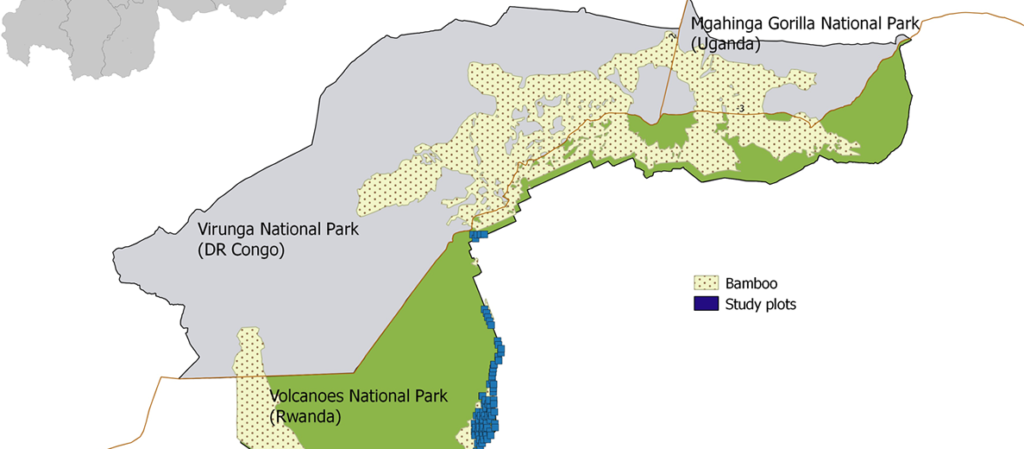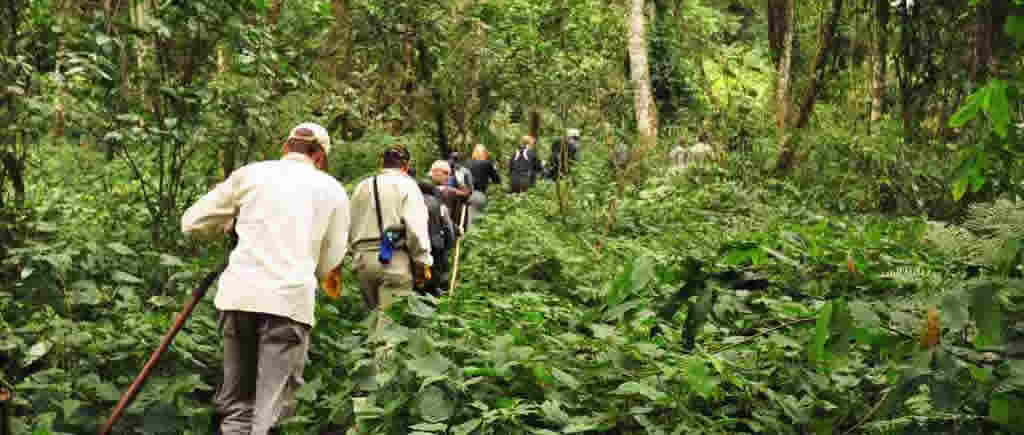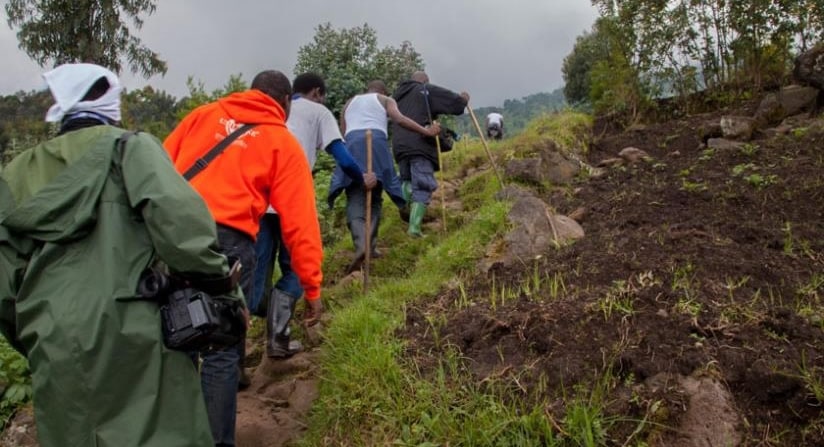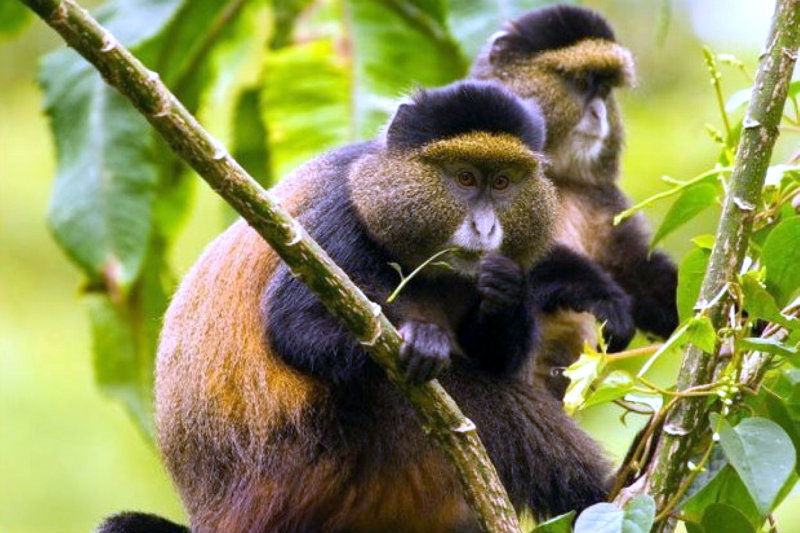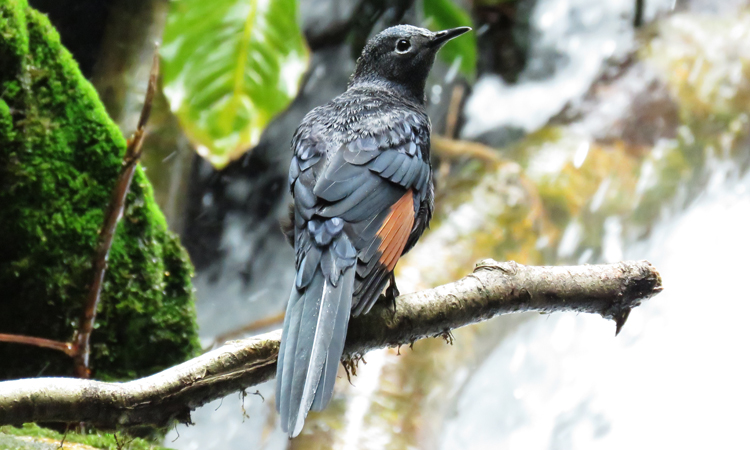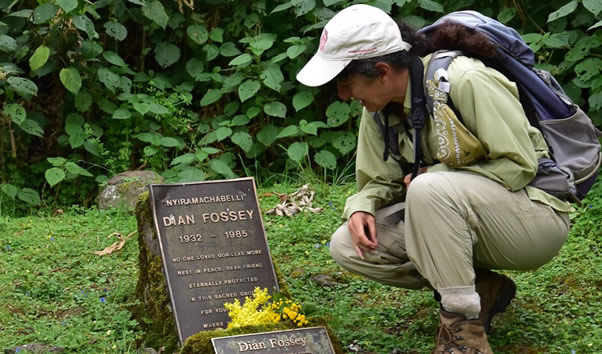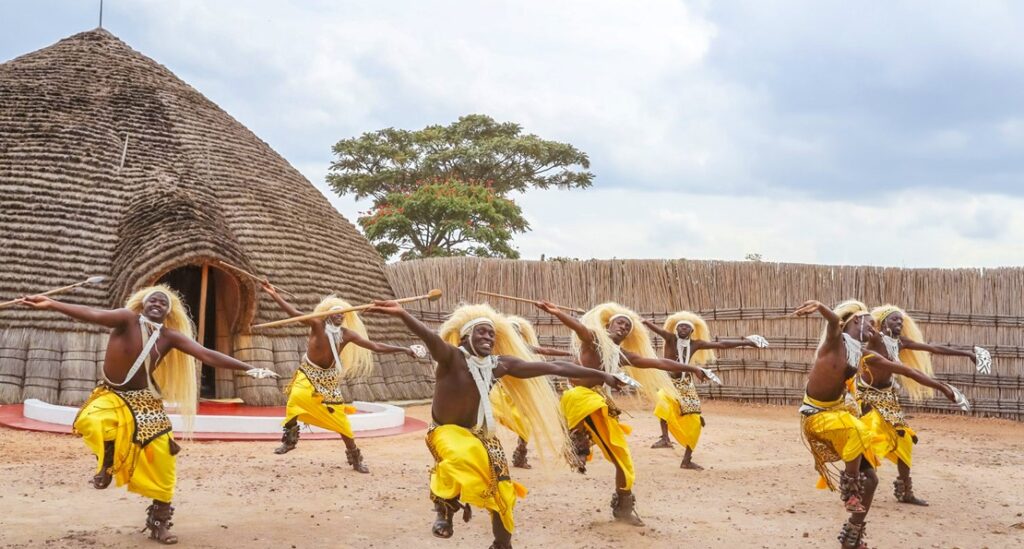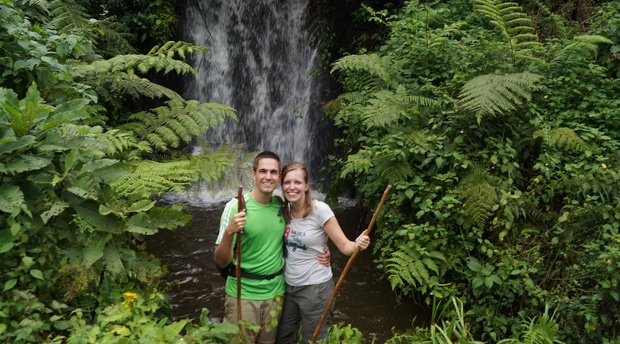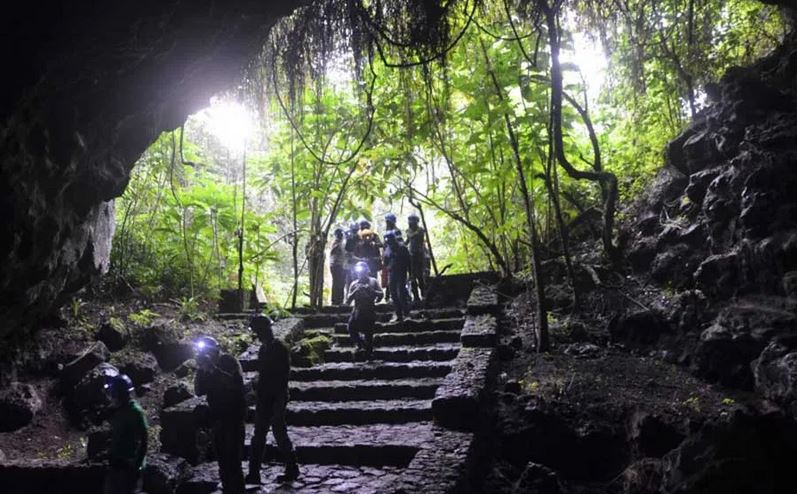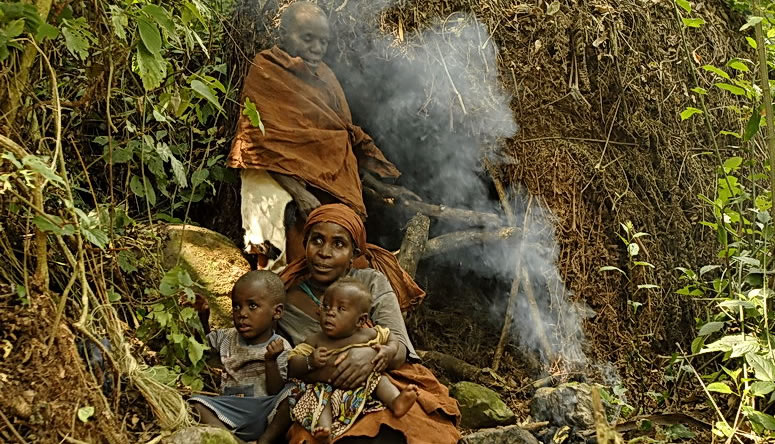Volcanoes national park (VNP) was established in 1925 and is one of the oldest protected areas in Africa. The park is located in the Musanze district of Northern Province 103 km (2-hour drive) north of Kigali’s capital city. VNP forms part of the Virunga massif and extends for 160 sq. km (62 sq.Miles) with 3 of the 8 Virunga volcanoes including Mount Karisimbi (4,507m), Mount Bisoke (3,711m) and Mount Sabinyo 3,634m. The Virunga mountains stretch for 80 sq. km (50 sq.Miles) and straddle the borders of Rwanda, Uganda, and DR Congo, creating the transboundary Virunga Conservation Area (VCA), which is home to 603 of the 1,063 world mountain gorilla population. Volcanoes national park is home to over 200 gorillas of which 12 families have been habituated for tourism since 1967 when Dian Fossey founded Karisoke Research Center with the purpose to prevent poaching and conserving gorillas in the Virunga area. Rwanda gorilla safaris thrive on her legacy and focus mostly on conservation. While you come for a gorilla trek, you should take time to walk in the footsteps of Fossey either through the Dian Fossey Tomb hike or visit the new Ellen DeGeneres Campus of the Dian Fossey Gorilla Fund. This will give you a chance to learn about the history and future of mountain gorilla research and conservation in Rwanda.
Vegetation
Due to the altitude variation from 1,800 m to 4,507 m, , Volcanoes National Park contains 3 vegetation zones including montane forest, bamboo, and afro-alpine. Farmlands for potatoes, coffee, and tea among other crops, and eucalyptus trees can be found in the villages that surround the park. Hiking trails from Kinigi to the park headquarters go through these cultivated fields to the park boundary, which is marked by pink ball (Dombeya) trees that continue to vanish. The montane forest zone and an extensive bamboo zone, which covers almost 30% of the park, start at 2,000m and stretch up to 2,600m. Given that both vegetation intertwin together, the forest ranges from dense, moderate to less dense, and open forest, making it easier to hike through. This zone is a habitat for golden monkeys, which can be tracked. There are also forest buffaloes and elephants but it is difficult to see them due to the nature of the terrain. From there, the subalpine zone (2,600m – 3,300m) contains hagenia hypericum forests mostly on the slopes of the Karisimbi volcano. You will see the trees covered by mosses and lichens. Finally, the afro-alpine zone dominates the higher elevations of the volcanoes above 4,000m. This zone contains rare plant species such as giant lobelias and senecios and on the hike to the top of Mount Bisoke, visitors will discover a beautiful crater lake.
Fauna
Volcanoes national park is famous for harboring over 300 mountain gorillas, golden monkeys, and over 178 species of birds of which 17 are Albertine Rift Endemics. Besides, the protected area is also home to mammal species such as forest elephants and buffaloes but these are hard to see due to the nature of the terrain.
Volcanoes national park activities
Gorilla trekking
 Volcanoes National Park’s less dense forests make it easier to hike through in search of gorillas. When compared to a trek through Bwindi, trekking in Rwanda can be less strenuous but requires physical fitness due to the nature of the terrain. For instance, going uphill is always challenging depending on the location of the gorillas, but walking downhill after viewing gorillas is always simpler. Rwanda puts much emphasis on conservation with a high-end low impact strategy. This is the reason why the gorilla permit, which is available for booking through RDB or a tour operator, was increased from $750 to $1,500 per person. As gorilla tourism continues to develop, there are several initiatives supporting the adjacent communities including the Gorilla Guardian’s Center (Iby’iwacu cultural village). Gorilla trekking safaris, therefore, go hand in hand with local community tours. Besides, some of the lodges offer responsible experiences including tree planting and Rwandan traditional dance performances that support locals while conserving the ecosystem. Be sure to visit Rwanda gorillas in a responsible manner from choosing a tour company, lodging, and activities.
Volcanoes National Park’s less dense forests make it easier to hike through in search of gorillas. When compared to a trek through Bwindi, trekking in Rwanda can be less strenuous but requires physical fitness due to the nature of the terrain. For instance, going uphill is always challenging depending on the location of the gorillas, but walking downhill after viewing gorillas is always simpler. Rwanda puts much emphasis on conservation with a high-end low impact strategy. This is the reason why the gorilla permit, which is available for booking through RDB or a tour operator, was increased from $750 to $1,500 per person. As gorilla tourism continues to develop, there are several initiatives supporting the adjacent communities including the Gorilla Guardian’s Center (Iby’iwacu cultural village). Gorilla trekking safaris, therefore, go hand in hand with local community tours. Besides, some of the lodges offer responsible experiences including tree planting and Rwandan traditional dance performances that support locals while conserving the ecosystem. Be sure to visit Rwanda gorillas in a responsible manner from choosing a tour company, lodging, and activities.
Now one of the biggest gorilla conservation projects is the expansion of Volcanoes national park. Given that Rwanda’s gorilla population has recently increased from 200 to 300 as indicated by the gorilla naming ceremony records. The increasing gorilla numbers put pressure on the habitat, whose size doesn’t expand accordingly. They thus begin to maraud among the nearby local communities. For that reason, the park is set to be expanded by 23% adding more land equivalent to 37.4 sq. km (3,740 hectares). In addition to the gorillas, Rwanda’s conservation efforts have made progress in recovering wildlife and ecosystems, including the restoration of the Big 5 in Akagera and the opening of new golden monkey tracking in Gishwati Mukura national park – a reminder to go green on your next Rwanda gorilla safari.
Bird watching
 Birding is one of the best reasons to go to Volcanoes national park, a well-known birding destination in Rwanda. Nearly 200 different bird species can be found in the park of which 17 are Albertine Rift Endemics including handsome francolin, red-faced woodland and Grauer’s swamp warbler, strange weaver and Archer’s robin chat. This group also consists of 5 Rwenzori Mountain Range Endemics including Rwenzori Apalis, Batis, turaco, nightjar and double-collared sunbird. Birding excursions are available for half or full days depending on the time you intend to spend in the park.
Birding is one of the best reasons to go to Volcanoes national park, a well-known birding destination in Rwanda. Nearly 200 different bird species can be found in the park of which 17 are Albertine Rift Endemics including handsome francolin, red-faced woodland and Grauer’s swamp warbler, strange weaver and Archer’s robin chat. This group also consists of 5 Rwenzori Mountain Range Endemics including Rwenzori Apalis, Batis, turaco, nightjar and double-collared sunbird. Birding excursions are available for half or full days depending on the time you intend to spend in the park.
Volcano hiking
Hikers in Volcanoes national park can climb Mount Bisoke and the Dian Fossey Tomb hike, which are day-long excursions. For those looking for a multiday hike, a two-day hike with a volcano camping experience is available on Mount Karisimbi. Hikers need to bring drinking water, a hat, sunscreen, and rain gear. Be ready for occasionally hot, damp, or rainy weather and hiking can be challenging due to the nature of the terrain.
Bisoke volcano
Mount Bisoke has an elevation of 3,711m and is the 3rd tallest volcano in the Virunga Massif. It is the most popular and easiest to hike in Volcanoes national park. It can be finished in a day given that it only takes 6 hours to ascend to the summit and 2 hours to descend. Along the trail, hikers will pass through untouched afro-alpine vegetation including moss-covered erica and epiphytic orchids in the montane forest zone. On the Bisoke climb, encounters with golden monkeys are frequent but not guaranteed. There is a small crater-filled lake on Bisoke’s summit, and a pathway through the swamp allows hikers to walk around. The panoramic view of the Virunga mountains is seen from the summit of Bisoke.
Mount Karisimbi
 Mount Karisimbi is a dormant volcano situated in Volcanoes N.P. along the border with DR Congo. With an altitude of 4,507m (14,787 feet), it is the tallest of the 8 Virunga mountains. The summit is almost covered in ‘thick white clouds’ during June and August, which is the meaning of the name Karisimbi. The volcano was formed between 900,000 to 130,000 years ago during the late Pleistocene epoch, making it the youngest of all. Hiking Karisimbi offers a chance to walk through 3 types of vegetation including dense montane forests, bamboo, and afro-alpine. The hike takes 2 days with camping on the higher slopes in the afro-alpine zone. The Karisimbi volcano campsite is set at 3,500 meters and features a tent set on a raised wooden platform covered by iron sheets. Firewood to use for cooking and campfire must be brought by porters all the way from Kingi. Deforestation isn’t allowed in the park.
Mount Karisimbi is a dormant volcano situated in Volcanoes N.P. along the border with DR Congo. With an altitude of 4,507m (14,787 feet), it is the tallest of the 8 Virunga mountains. The summit is almost covered in ‘thick white clouds’ during June and August, which is the meaning of the name Karisimbi. The volcano was formed between 900,000 to 130,000 years ago during the late Pleistocene epoch, making it the youngest of all. Hiking Karisimbi offers a chance to walk through 3 types of vegetation including dense montane forests, bamboo, and afro-alpine. The hike takes 2 days with camping on the higher slopes in the afro-alpine zone. The Karisimbi volcano campsite is set at 3,500 meters and features a tent set on a raised wooden platform covered by iron sheets. Firewood to use for cooking and campfire must be brought by porters all the way from Kingi. Deforestation isn’t allowed in the park.
Depending on the hikers’ pace, it takes 3-5 hours to walk from Kinigi to the campsite, where the views of Gahinga, Sabinyo, and Muhabura volcanoes are visible on clear skies. The weather is mostly sunny and warm but temperatures at the summit can drop to 3 degrees Celsius. From the campsite, it takes 2 hours to ascend to the summit and 1 hour to descend back. However, experienced hikers can go all the way to the summit and return to the camp in the evening. Hiking can be challenging due to the nature of the terrain. The packing list for Karisimbi volcano climbing should include a sleeping bag, sturdy hiking boots, rain jacket and sweater, sun hat, insect repellant, food, drinks and snacks of personal choice, and a torch. Some of your valuable items can be left at the lodge. Each hiker needs to hire a cook to prepare meals and carry the luggage.
Cultural experience at the Gorilla Guardian’s Center
Visiting the gorilla guardians center formerly known as Iby’iwacu cultural village is one way of supporting local communities including ex-poachers. Given that the villagers gain from tourism, they are less likely to return to poaching, which aids in the protection of gorillas and their habitats. The cultural village can be visited at any time of day, although it is best to go there in the evening after going on a gorilla or golden monkey trek. Through traditional Intore dance performances, and king and queen marriage ceremonies, the community walk offers an educational experience about Rwandan culture. For visitors planning to spend the night, the center also provides lodging with a rural feel, traditional cuisine, and a stunning view of the Virunga volcanoes.
Attractions outside the park
The northern lakes
Rwanda’s Northern Province is home to over 5 lakes including the twin lakes of Burera and Ruhondo, Lake Karago, lake Bihanga and Lake Nyirakigugu. All are crater lakes filled with freshwater situated between 1,750m – 2,350 meters above sea level. The lakes have been preserved and provide a home to over 232 species of birds including the endangered gray crowned crane (Balearica regulorum), and the woodchat shrike (Lanius senator). They are some of the best birding areas in Rwanda. In particular, the twin lakes of Burera and Ruhondo have attracted the development of hotels and adventure activities including canoeing, boat trips, hiking, and birding.
The twin lakes, which are situated 21.5 km (40 min drive) north of Kinigi visitor center can be visited after gorilla trekking in Volcanoes national park.
Buhanga Sacred Forest
 The tropical Buhanga forest covers 31 hectares and is situated in Nyakinama village 8 km west of Musanze town. According to local folklore (at the King’s Palace in Nyanza Southern Province), Buhanga was a coronation site of the ancient Rwanda monarchy. Gihanga, who is believed to have been the first Rwandan king, preserved the forest and his successors maintained it. Today, the Buhanga forest has been turned into an Eco-tourism park with trails for visitors to explore the caves, birds, and culture. Buhanga Eco-Park is a must-visit gem for those intending to go off-the-beaten path during the northern Rwanda safari.
The tropical Buhanga forest covers 31 hectares and is situated in Nyakinama village 8 km west of Musanze town. According to local folklore (at the King’s Palace in Nyanza Southern Province), Buhanga was a coronation site of the ancient Rwanda monarchy. Gihanga, who is believed to have been the first Rwandan king, preserved the forest and his successors maintained it. Today, the Buhanga forest has been turned into an Eco-tourism park with trails for visitors to explore the caves, birds, and culture. Buhanga Eco-Park is a must-visit gem for those intending to go off-the-beaten path during the northern Rwanda safari.
Rugezi wetland
Rugezi swamp is one of the few Virunga massifs high altitude wetlands situated at 6,900 feet(2,100 meters above sea level). The marsh covers 16,640 acres (6,735 hectares) and is the only Ramsar site in Rwanda with 194 species of birds including Grauer’s swamp warbler (Bradypeterus graueri) one of the 17 Albertine rift endemics. The swamps is also a habitat for the endangered grey crowned cranes along with the papyrus yellow warbler (Calamonastides gracilirostris), which is listed as vulnerable on the criteria of the IUCN red list of endangered species.
The Ellen DeGeneres campus of the Dian Fossey Gorilla Fund
 The Ellen campus is 4.3 km from Kinigi, the headquarters of Volcanoes national park. The center was established in 2018 with support from Portia de Rossi, an American-Australian former actress with a mission to uphold the legacy of Dian Fossy. Fossey is famous for establishing the Karisoke research center in 1967 in Volcanoes national park. At the time, the gorilla population was less than 500 individuals. Fossey dedicated her life to saving gorillas through her
The Ellen campus is 4.3 km from Kinigi, the headquarters of Volcanoes national park. The center was established in 2018 with support from Portia de Rossi, an American-Australian former actress with a mission to uphold the legacy of Dian Fossy. Fossey is famous for establishing the Karisoke research center in 1967 in Volcanoes national park. At the time, the gorilla population was less than 500 individuals. Fossey dedicated her life to saving gorillas through her
anti-poaching campaign called Digit Fund, which later turned into the Dian Fossey Gorilla Fund International (DGFI). Fossey was murdered in 1985 but had already laid a solid foundation that was used by the International Gorilla Conservation Program (IGCP) to continue the necessary research and conservation of gorillas. For so long the offices of Fossey Fund remained in incommodious structures and far away from the gorillas, making it difficult for the primate research team to carry out their work. The new Ellen campus is a state-of-the-art facility for tourism, conservation, science, research, and education. It will ease and support the work of the Dian Fossey Gorilla Fund to continue to protect and conserve gorillas while also grooming the next generation of conservationists.
How to get there
Volcanoes national park is 103 km (2-hour drive) north of Kigali’s capital city. The park can also be reached by air through Akagera Aviation private helicopter tours. Those coming from southwest Uganda’s Bwindi or Mgahinga national parks can reach Kinigi via the Cyanika border town of Rwanda, which is 81 km (3-hour drive).






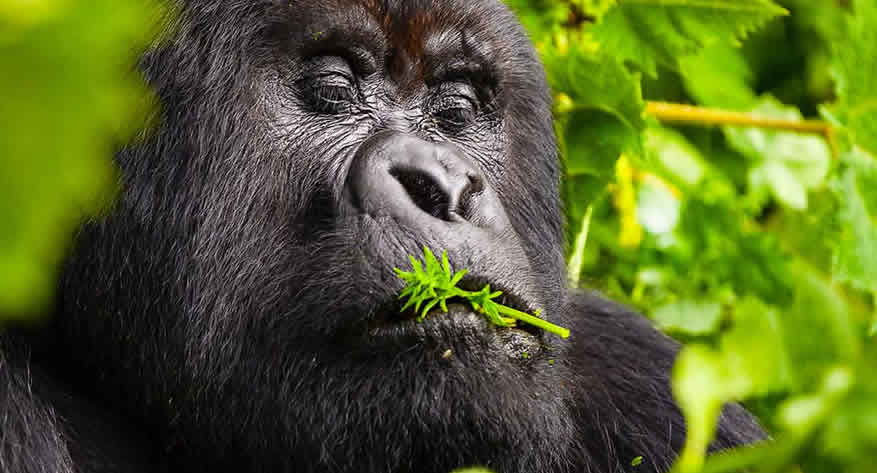
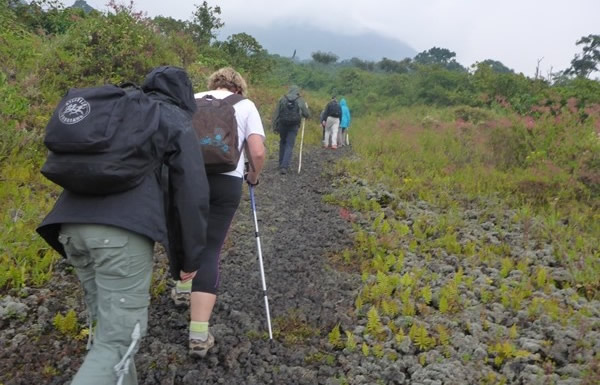
 The Karisimbi volcano (4,507m (14,787 feet) is dormant and the tallest among the 8 Virunga Mountains. It is thought to have been formed during the Pleistocene period about 130,000 to 900,000 years ago, thus younger than the Sabinyo and Mikeno (DR Congo). Karisimbi volcano has a depression devoid of water but sometimes the top is covered in thick mist. (Karisimbi means “thick clouds” in English). This 2-day volcano climb begins at Kinigi and the first day involves hiking to the campground where you stay in tents. On the second you hike to the top and return straight to Kinigi. Visitors can hire porters and a cook at extra cost to assist with the arrangement of meals and carry luggage. However, Karisimbi can also be completed in a single day. In regard to that, the 1-day Karisimbi hike can last 7 to 9 hours depending on the experience and pace of the hikers. No technical gear is required, though hiking is challenging due to the nature of the terrain. The permit cost is $300 per person and includes the fee for rangers and guides. However, you can carry some extra cash to tip your ranger as appreciation. The guides will help to identify flora and fauna, mostly birds and occasionally some gorilla encounters.
The Karisimbi volcano (4,507m (14,787 feet) is dormant and the tallest among the 8 Virunga Mountains. It is thought to have been formed during the Pleistocene period about 130,000 to 900,000 years ago, thus younger than the Sabinyo and Mikeno (DR Congo). Karisimbi volcano has a depression devoid of water but sometimes the top is covered in thick mist. (Karisimbi means “thick clouds” in English). This 2-day volcano climb begins at Kinigi and the first day involves hiking to the campground where you stay in tents. On the second you hike to the top and return straight to Kinigi. Visitors can hire porters and a cook at extra cost to assist with the arrangement of meals and carry luggage. However, Karisimbi can also be completed in a single day. In regard to that, the 1-day Karisimbi hike can last 7 to 9 hours depending on the experience and pace of the hikers. No technical gear is required, though hiking is challenging due to the nature of the terrain. The permit cost is $300 per person and includes the fee for rangers and guides. However, you can carry some extra cash to tip your ranger as appreciation. The guides will help to identify flora and fauna, mostly birds and occasionally some gorilla encounters.
 Dian Fossey was an American primatologist who lived for nearly 20 years in a cabin located in a saddle between Karisimbi and Bisoke volcanoes in Volcanoes National Park. During her research and study of mountain gorillas for nearly 20 years, she established the Karisoke center in 1967 which later evolved into the Dian Fossey Gorilla Fund International (DFGFI) – the world’s leading organization in the protection and conservation of mountain gorillas while supporting the sustainable livelihoods of local communities living adjacent to the protected area. Gorillas were near the verge of extinction due to human poaching and encroachment. Fossey’s approach to stopping was rather perceived as ha
Dian Fossey was an American primatologist who lived for nearly 20 years in a cabin located in a saddle between Karisimbi and Bisoke volcanoes in Volcanoes National Park. During her research and study of mountain gorillas for nearly 20 years, she established the Karisoke center in 1967 which later evolved into the Dian Fossey Gorilla Fund International (DFGFI) – the world’s leading organization in the protection and conservation of mountain gorillas while supporting the sustainable livelihoods of local communities living adjacent to the protected area. Gorillas were near the verge of extinction due to human poaching and encroachment. Fossey’s approach to stopping was rather perceived as ha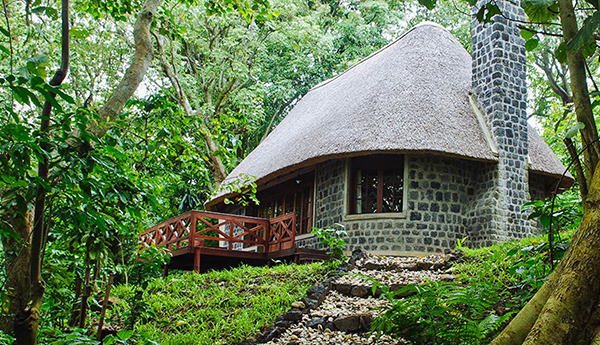
 Established in 2011, Mikeno lodges was the first tourist lodge opened for travelers in Virunga National park. The luxury lodge comprises of 12 private bungalows which contain a bathroom, toilet, lounge corner, fireplace, and separate stone tower. Virunga Energies’ hydroelectric station is the major supplier of electricity to Mikeno Lodge. Staying at Mikeno lodge gives you chance to visit the Senkwekwe Centre where orphaned mountain gorillas live and also the Virunga’s canine anti-poaching unit. Mountain gorilla trekking, Nyiragongo volcano climbing, bird watching, community tours, and forest walks are some of the activities to do while staying at Mikeno Lodge.
Established in 2011, Mikeno lodges was the first tourist lodge opened for travelers in Virunga National park. The luxury lodge comprises of 12 private bungalows which contain a bathroom, toilet, lounge corner, fireplace, and separate stone tower. Virunga Energies’ hydroelectric station is the major supplier of electricity to Mikeno Lodge. Staying at Mikeno lodge gives you chance to visit the Senkwekwe Centre where orphaned mountain gorillas live and also the Virunga’s canine anti-poaching unit. Mountain gorilla trekking, Nyiragongo volcano climbing, bird watching, community tours, and forest walks are some of the activities to do while staying at Mikeno Lodge.  Located on the slopes of Mount Mikeno, Kibumba tented camp is the main accommodation for all mountain gorilla safaris in Virunga National Park. The Tented camp also offers you clear views of Mt Karisimbi in Rwanda, and Nyiragongo, and Nyamuragira volcanoes in Virunga National park. Kibumba Tented camp comprises 18 self-contained tents, which are designed in traditional styles. The permanent source of power to this lodge is the Matebe Hydroelectric plant. Travelers staying at Kimumba tented camp can take part in different activities such as gorilla trekking, bird watching, forest walks, golden monkey trekking, and volcano climbing among other adventures.
Located on the slopes of Mount Mikeno, Kibumba tented camp is the main accommodation for all mountain gorilla safaris in Virunga National Park. The Tented camp also offers you clear views of Mt Karisimbi in Rwanda, and Nyiragongo, and Nyamuragira volcanoes in Virunga National park. Kibumba Tented camp comprises 18 self-contained tents, which are designed in traditional styles. The permanent source of power to this lodge is the Matebe Hydroelectric plant. Travelers staying at Kimumba tented camp can take part in different activities such as gorilla trekking, bird watching, forest walks, golden monkey trekking, and volcano climbing among other adventures.  Located near Virunga National Park, Bukima Tented camp was the former research station, which later transformed into a major accommodation facility for travelers visiting mountain gorillas in Virunga National Park. There are times when gorillas roam on the camp premises, an interesting encounter for travelers staying there. Near the camp is a lava tunnel, which any traveler must not miss during his/her stay at Bukima Tented Camp.
Located near Virunga National Park, Bukima Tented camp was the former research station, which later transformed into a major accommodation facility for travelers visiting mountain gorillas in Virunga National Park. There are times when gorillas roam on the camp premises, an interesting encounter for travelers staying there. Near the camp is a lava tunnel, which any traveler must not miss during his/her stay at Bukima Tented Camp.  For those visiting Congo for the Mount Nyiragongo Volcano experience, the best place to stay is in the Nyiragongo summit shelters. The fact that hiking Nyiragongo entails an overnight on the summit, you need a safe and comfortable place to spend a night. A 3 Days Mount Nyiragongo hike is the best package to experience this active volcano with a boiling Lava Lake.
For those visiting Congo for the Mount Nyiragongo Volcano experience, the best place to stay is in the Nyiragongo summit shelters. The fact that hiking Nyiragongo entails an overnight on the summit, you need a safe and comfortable place to spend a night. A 3 Days Mount Nyiragongo hike is the best package to experience this active volcano with a boiling Lava Lake. 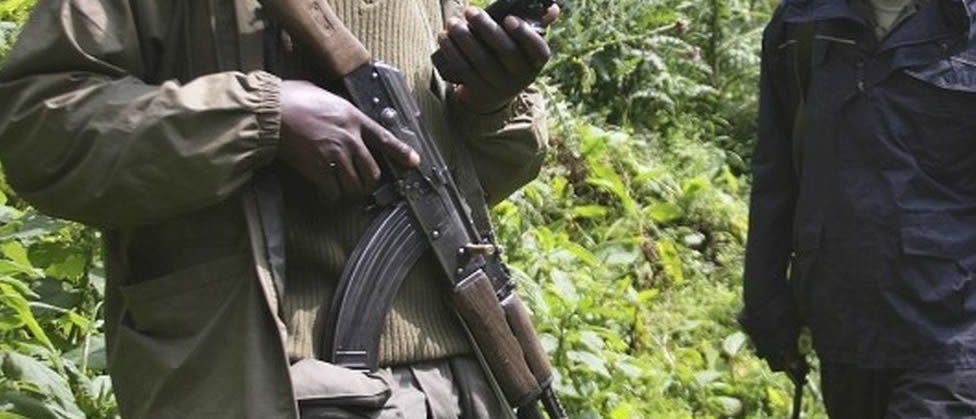
 YES, trips to trek mountain gorillas are the most popular in
YES, trips to trek mountain gorillas are the most popular in  With over 706 bird species, Virunga National park is a haven for birders. Expect to see a variety of birds some of which are endemic to the Albertine rift. Among the birds to see in Virunga National park include the Kivu Ground thrush, Blue-headed coucal, African Goshawk, Dusky Crimson-wing, Rwenzori double-collared sunbird, Grassland pipit, Barred long-tailed cuckoo, Malachite sunbird, Diederick cuckoo, Mountain sooty boubou, Brown woodland warbler, Yellow-rumped tinker bird, Alpine swift, Olive sunbird, Tropical boubou, Yellow white-eye, Angola swallow, Red-eyed-slaty flycatcher, Olive woodpecker, Black bishop, Bronze manikin, pin-tailed whydah, Archer’s ground robin, Chubb’s cisticola, bronze manikin, and mountain oriole among others. Birding in Virunga Park s done all year round but the dry season between June and September is the best time to see birds in Virunga Park. Migratory birds are present between November and April.
With over 706 bird species, Virunga National park is a haven for birders. Expect to see a variety of birds some of which are endemic to the Albertine rift. Among the birds to see in Virunga National park include the Kivu Ground thrush, Blue-headed coucal, African Goshawk, Dusky Crimson-wing, Rwenzori double-collared sunbird, Grassland pipit, Barred long-tailed cuckoo, Malachite sunbird, Diederick cuckoo, Mountain sooty boubou, Brown woodland warbler, Yellow-rumped tinker bird, Alpine swift, Olive sunbird, Tropical boubou, Yellow white-eye, Angola swallow, Red-eyed-slaty flycatcher, Olive woodpecker, Black bishop, Bronze manikin, pin-tailed whydah, Archer’s ground robin, Chubb’s cisticola, bronze manikin, and mountain oriole among others. Birding in Virunga Park s done all year round but the dry season between June and September is the best time to see birds in Virunga Park. Migratory birds are present between November and April.  Sheltering over 200 bird species, Volcanoes National park is the best bird-watching spot in Rwanda. 17 bird species in
Sheltering over 200 bird species, Volcanoes National park is the best bird-watching spot in Rwanda. 17 bird species in  Mgahinga Gorilla National park is home to roughly 180 bird species 12 of which are endemic and not found anywhere else in Uganda. Whereas the park is famous for gorillas, golden monkeys, and volcanoes, bird watching is another interesting activity you should not miss on your Uganda safari to
Mgahinga Gorilla National park is home to roughly 180 bird species 12 of which are endemic and not found anywhere else in Uganda. Whereas the park is famous for gorillas, golden monkeys, and volcanoes, bird watching is another interesting activity you should not miss on your Uganda safari to  Discover birds in
Discover birds in 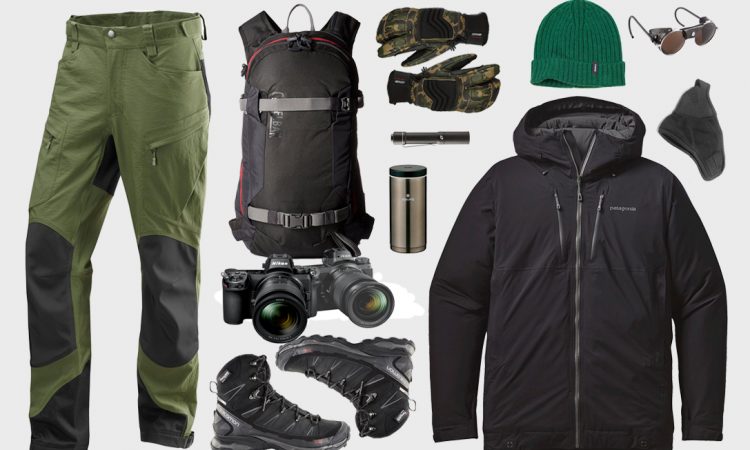
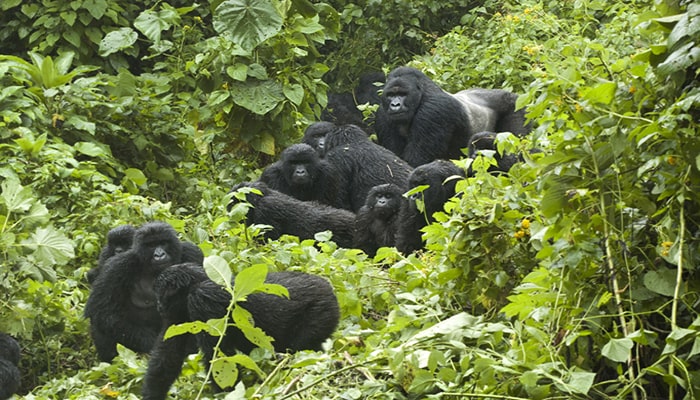
 Gorilla trekking in Rwanda guarantees an ultimate gorilla encounter, a perfect destination for tourists who prefer luxury gorilla safaris. This is a typical example of a high-end African safari destination. 12 gorilla families are all available for tracking in Rwanda alone, and there is only one location to set foot to search for the massive mountain gorillas.
Gorilla trekking in Rwanda guarantees an ultimate gorilla encounter, a perfect destination for tourists who prefer luxury gorilla safaris. This is a typical example of a high-end African safari destination. 12 gorilla families are all available for tracking in Rwanda alone, and there is only one location to set foot to search for the massive mountain gorillas. Trekking with Uganda gorillas is done in 2 locations; Bwindi Impenetrable National Park and
Trekking with Uganda gorillas is done in 2 locations; Bwindi Impenetrable National Park and  Lying within the Musanze region just next to Kinigi offices of Volcanoes National Park, Sabyinyo Silverback Lodge is a luxury lodge anyone visiting Rwanda for gorilla trekking should consider for an overnight stay. This 5-Star lodge lies at the base of the Virunga volcanoes guaranteeing guests absolutely breathtaking views of the surrounding volcanoes and countryside. Sabyinyo Silverback Lodge is managed by Governor’s Camp and it consists of 8 (eight) cottages, each providing a clear view of the park and guests enjoy ultimate privacy.
Lying within the Musanze region just next to Kinigi offices of Volcanoes National Park, Sabyinyo Silverback Lodge is a luxury lodge anyone visiting Rwanda for gorilla trekking should consider for an overnight stay. This 5-Star lodge lies at the base of the Virunga volcanoes guaranteeing guests absolutely breathtaking views of the surrounding volcanoes and countryside. Sabyinyo Silverback Lodge is managed by Governor’s Camp and it consists of 8 (eight) cottages, each providing a clear view of the park and guests enjoy ultimate privacy.
 Da Vinci Gorilla Lodge is a standard hospitality facility, located in Volcanoes National Park. It is one of the newly set up mid-range lodges strategically built in Kinigi, about 20 minute drive away. It has 5 cottages and its rooms come with facilities such as private bathrooms, large opening windows, a living room, cozy beds, pair of slippers, a fireplace and heaters, Free Wi-Fi, and bottled water. The main facilities at Da Vinci Lodge include 24-hour room service, a restaurant, fast internet, a fully stocked bar, hot water showers, laundry, a lounge, and more.
Da Vinci Gorilla Lodge is a standard hospitality facility, located in Volcanoes National Park. It is one of the newly set up mid-range lodges strategically built in Kinigi, about 20 minute drive away. It has 5 cottages and its rooms come with facilities such as private bathrooms, large opening windows, a living room, cozy beds, pair of slippers, a fireplace and heaters, Free Wi-Fi, and bottled water. The main facilities at Da Vinci Lodge include 24-hour room service, a restaurant, fast internet, a fully stocked bar, hot water showers, laundry, a lounge, and more. 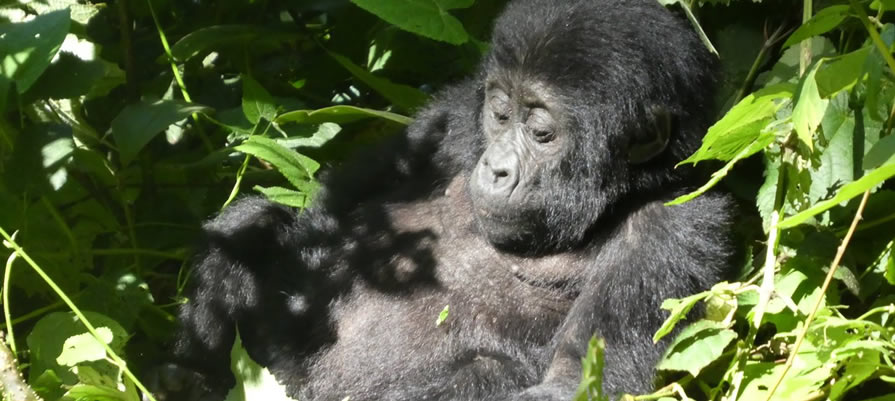
 The Susa A is perhaps the most famous gorilla group, and it is where Dian Fossey carried out her research on gorillas. She did camping in the Virunga Region from 1967 to 1985 studying more about the daily gorilla behaviors. Unfortunately, she mysteriously died but left a remarkable legacy. The Susa A group originally consisted of 42 gorillas and these apes roam at the higher altitude. The group later split reducing its members to about 28 featuring 3 silverback gorillas.
The Susa A is perhaps the most famous gorilla group, and it is where Dian Fossey carried out her research on gorillas. She did camping in the Virunga Region from 1967 to 1985 studying more about the daily gorilla behaviors. Unfortunately, she mysteriously died but left a remarkable legacy. The Susa A group originally consisted of 42 gorillas and these apes roam at the higher altitude. The group later split reducing its members to about 28 featuring 3 silverback gorillas.  Agashya takes its name as Group 13 considering the number of mountain gorillas that originally made up the family. It was led by Nyakarima, but he was challenged by Agashya leading to the creation of Group 13. The word Agashya refers to “The News.” It is believed that before Agashya silverback could incite Nyakarima into a fight, he used to assess his strength.
Agashya takes its name as Group 13 considering the number of mountain gorillas that originally made up the family. It was led by Nyakarima, but he was challenged by Agashya leading to the creation of Group 13. The word Agashya refers to “The News.” It is believed that before Agashya silverback could incite Nyakarima into a fight, he used to assess his strength. Ugenda family takes its name from Kinyarwanda word Ugenda meaning “on the move/mobile.” It is one group with 11 mountain gorillas including 2 silverbacks, females and babies. They seem not to prefer staying in one location and tracking them involves navigating through long distances in the forest before you find finally come across these apes.
Ugenda family takes its name from Kinyarwanda word Ugenda meaning “on the move/mobile.” It is one group with 11 mountain gorillas including 2 silverbacks, females and babies. They seem not to prefer staying in one location and tracking them involves navigating through long distances in the forest before you find finally come across these apes. 